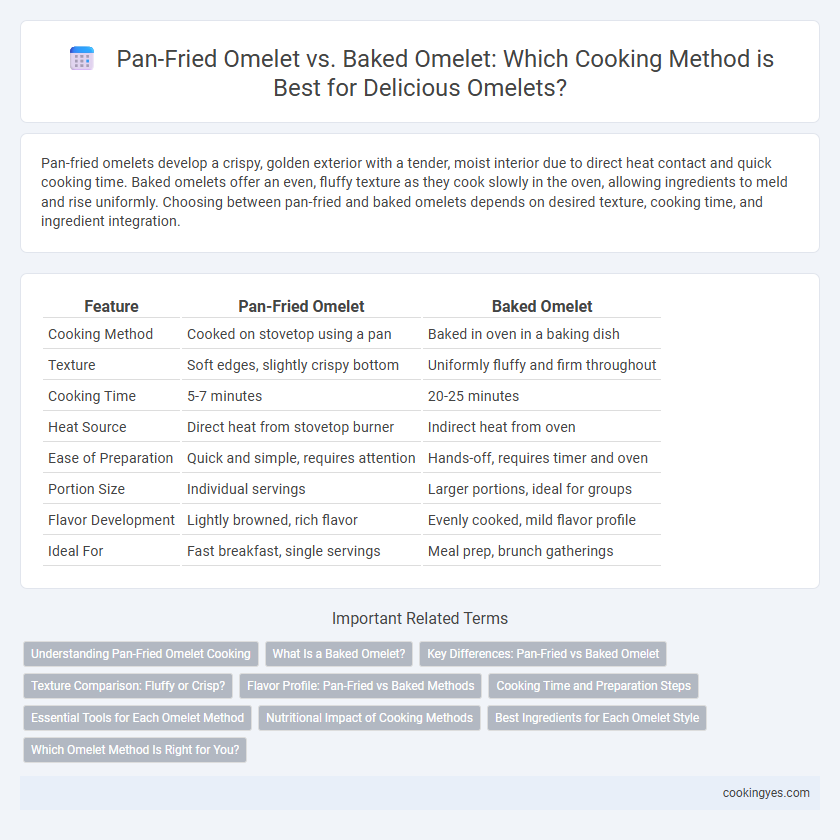Pan-fried omelets develop a crispy, golden exterior with a tender, moist interior due to direct heat contact and quick cooking time. Baked omelets offer an even, fluffy texture as they cook slowly in the oven, allowing ingredients to meld and rise uniformly. Choosing between pan-fried and baked omelets depends on desired texture, cooking time, and ingredient integration.
Table of Comparison
| Feature | Pan-Fried Omelet | Baked Omelet |
|---|---|---|
| Cooking Method | Cooked on stovetop using a pan | Baked in oven in a baking dish |
| Texture | Soft edges, slightly crispy bottom | Uniformly fluffy and firm throughout |
| Cooking Time | 5-7 minutes | 20-25 minutes |
| Heat Source | Direct heat from stovetop burner | Indirect heat from oven |
| Ease of Preparation | Quick and simple, requires attention | Hands-off, requires timer and oven |
| Portion Size | Individual servings | Larger portions, ideal for groups |
| Flavor Development | Lightly browned, rich flavor | Evenly cooked, mild flavor profile |
| Ideal For | Fast breakfast, single servings | Meal prep, brunch gatherings |
Understanding Pan-Fried Omelet Cooking
Pan-fried omelets cook quickly over medium-high heat, creating a golden, slightly crispy exterior while preserving a tender, moist interior. This method uses minimal oil and requires careful heat control and flipping to avoid burning and ensure even cooking. Pan-frying allows for more control over texture compared to baked omelets, which cook evenly but lack the crispiness and quick, stovetop versatility.
What Is a Baked Omelet?
A baked omelet is a fluffy, oven-cooked dish made by whisking eggs with various fillings such as vegetables, cheese, and meats, then baking the mixture in a preheated oven until set and lightly browned. Unlike pan-fried omelets that cook quickly on the stovetop and require folding, baked omelets offer even cooking and a tender, casserole-like texture, making them ideal for serving multiple portions. The baking method allows for consistent heat distribution and a thicker, more souffle-like result compared to the thinner, crispier edges of pan-fried omelets.
Key Differences: Pan-Fried vs Baked Omelet
Pan-fried omelets are cooked quickly over medium heat, creating a golden, slightly crispy exterior while remaining soft inside, ideal for adding fillings that require fast cooking. Baked omelets, prepared in the oven at a consistent temperature, offer a uniform texture and are excellent for incorporating bulky ingredients like vegetables and cheese without flipping. The key difference lies in texture and cooking time: pan-frying delivers a tender, crisp edge with quicker preparation, whereas baking ensures even cooking and a fluffier, more set consistency.
Texture Comparison: Fluffy or Crisp?
Pan-fried omelets develop a slightly crisp, golden exterior while maintaining a soft and fluffy interior due to direct contact with high heat and quick cooking. Baked omelets offer a uniformly fluffy texture throughout with a tender yet firm structure as the gentle, even heat allows the eggs to set slowly. The choice between pan-fried and baked omelets depends on whether you prefer a contrast of crispness and fluffiness or an overall light, airy consistency.
Flavor Profile: Pan-Fried vs Baked Methods
Pan-fried omelets develop a rich, caramelized crust that intensifies the savory and slightly smoky flavors due to direct contact with high heat and oil. Baked omelets offer a more uniform, tender texture with a subtle, delicate flavor profile as the gentle oven heat evenly cooks the eggs, allowing added ingredients like herbs and cheese to meld harmoniously. The pan-fried method provides a robust, bold taste, while baking yields a lighter, fluffier result ideal for incorporating diverse fillings.
Cooking Time and Preparation Steps
Pan-fried omelets typically cook in 3 to 5 minutes with minimal preparation involving whisking eggs and direct stovetop frying, resulting in a soft, slightly crispy texture. Baked omelets require 15 to 25 minutes, incorporating steps like mixing eggs with fillings and baking in an oven-safe dish, producing a firmer and evenly cooked dish. The quicker stovetop method suits fast meals, while baking allows for more complex ingredient combinations and consistent heat distribution.
Essential Tools for Each Omelet Method
Pan-fried omelets require a non-stick skillet or frying pan, a spatula for flipping, and a stove or cooktop for direct heat application. Baked omelets necessitate an oven-safe dish or ramekins, an oven preheated to the desired temperature, and often a mixing bowl for combining ingredients before baking. Quality pans and reliable temperature control are essential for achieving the perfect texture in both cooking methods.
Nutritional Impact of Cooking Methods
Pan-fried omelets retain more fat due to oil absorption, increasing calorie content compared to baked omelets, which use little to no oil and reduce overall fat intake. Baking preserves more water-soluble vitamins like B-complex, while pan-frying at high temperatures can degrade these nutrients. Protein digestibility remains high in both methods, but baked omelets often maintain a better nutrient profile due to gentler cooking temperatures.
Best Ingredients for Each Omelet Style
Pan-fried omelets benefit from ingredients like fresh herbs, diced vegetables, and cheeses that melt quickly, such as cheddar or mozzarella, which enhance flavor and texture through direct heat. Baked omelets are ideal for heartier fillings like roasted vegetables, sausage, and firmer cheeses like feta or goat cheese, as the even oven heat allows thorough cooking without burning. Choosing the right ingredients ensures optimal taste and consistency tailored to the pan-fry or bake cooking method.
Which Omelet Method Is Right for You?
Pan-fried omelets offer a quick, crispy texture with a golden exterior and soft interior, ideal for those seeking a traditional, stovetop-cooked meal that allows easy additions like cheese and vegetables. Baked omelets provide a hands-off cooking experience, resulting in a fluffier, evenly cooked dish suitable for meal prepping or feeding larger groups. Choosing between pan-fried and baked omelets depends on your desired texture, preparation time, and convenience preferences.
Pan-fried omelet vs Baked omelet for cooking method Infographic

 cookingyes.com
cookingyes.com